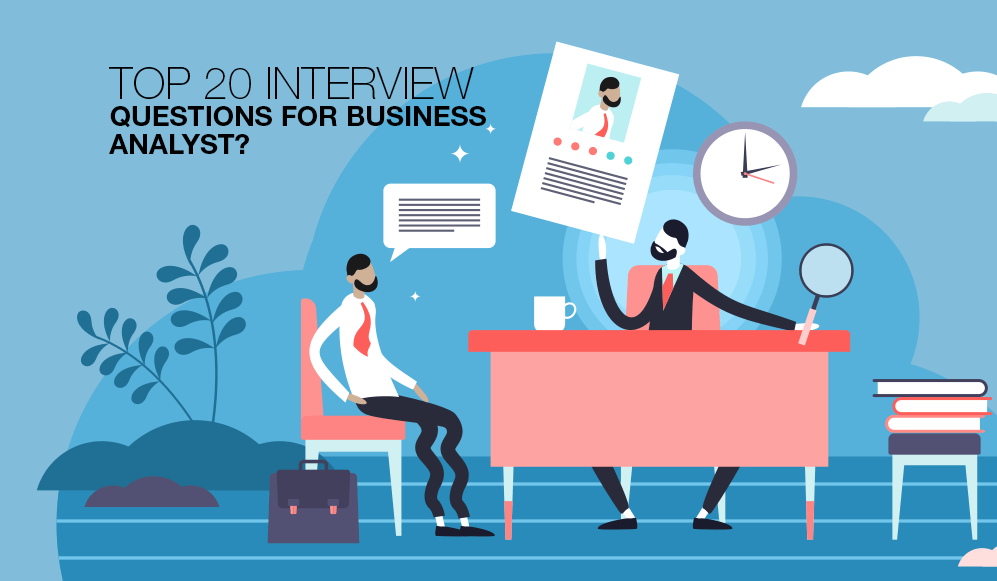Top 20 Interview Questions for Business Analyst
Are you applying for a Business Analyst role? Before going for an interview, it’s best to prepare the possible questions likely to come up.
1. What are some common documents that a business analyst uses to handle?
Some of the common documents are
-
- User Stories
- Business Analysis plan
- Business Requirement Document (BRD)
- Functional Requirement Specification (FRS)
- Requirement Traceability Matrix
- Visual document (Wireframe, website prototype)
- Use Case Diagrams
- Test Cases, UAT
- Change Management
2. What is a requirement?
A requirement is something that’s needed or required to achieve business goals or objectives. It acts as an input for the various stages of SDLC. This acts as a basis of a project which stakeholders and business users verify before moving to the analysis or design phase. Therefore, each requirement needs to be properly documented for future use.
3. What is Use Case?
A Use-case explains a sequence of actions performed by a system in a diagrammatic representation. In other words, how a user or system will accomplish a goal under various conditions.
4. What steps need to be followed while designing a Use Case?
-
- Identify the users of the system
- Create a user profile and include all the users’ roles relevant to the system.
- Identify goals associated with each role.
- Designing use cases for every goal associated with the system.
- Validating and verifying the users
5. What is Gap Analysis?
A Gap Analysis compares the actual results with the desired or expected outcome. This process helps to identify the missing strategies, structures, capabilities, technology, or skills and then recommends the steps that need to be implemented in the project to achieve its business goals.
Gap Analysis = To Be (Future State) – As-Is (Current state)
6. What are the essential elements of the SRS document?
-
- Scope of project
- Constraints, Dependencies
- Functional / Technical Requirements
- System requirements
- Assumptions
- Acceptance Criteria
7. How is BRD different from SRS?
BRD is a high-level functional specification of the software, and SRS is a detailed illustration of the software’s high-level functional and technical specifications. BRD is developed based on the requirements from client interaction, and SRS is developed from BRD. A BRD document is prepared during the analysis phase, and SRS will be prepared
during the planning phase of the project.
8. Define Persona?
Personas are used to help the application designers fully understand the diverse interests and behavior of the users within the different demographic segments. The various types of Personas include
-
- Goal-directed Personas
- Role-based Personas
- Engaging Personas
- Fictional Personas
9. What do you know about the techniques of MoSCoW and SWOT?
MoSCoW stands for Must-have requirements, Should-have requirements, Could-have requirements, or Won’t-have requirements.
Must-have requirements
The final product or software would not be yielded without this requirement. Without this requirement, there will not be a point in completing the target goal.
Should-have requirements:
This set of requirements is for future release without impacting the current project.
Could-have requirements:
This set of requirements has a minor impact on the project deliverables.
Won’t-have requirements:
This set of requirements comes with the least priority, and the requirements of this category will be reprioritized and worked into future projects.
10. What are the knowledge areas a business analyst needs to know?
A business analyst needs to know business analysis, product management, technical knowledge, including an understanding of testing.
-
- Behavioral and personality-related
- Analytical thinking skills
- Communication
- Relationship building
- Influencing and leadership skills
- Team player and management skills
- Political awareness/understanding of organizational dynamics
- Eye for detail.
11. What tools are helpful to you?
As Business Analysts most essential tools we use are
MS Vision, MS Word, MS Excel, MS PowerPoint, MS Project.
12. What do you mean by Critical Path Analysis?
Critical Path Analysis (CPA) is one of the widely used Project management techniques that help map out every important task required to complete a project. The necessity of the CPA technique is to construct a successful model for the project that includes:
-
- Task lists needed to complete the project
- The time is taken to complete each task
- The dependencies between the interfaces
While using all the above information, CPA calculates the longest path of planned activities to complete a project. Therefore, any unexpected activity delay in the Critical path will directly impact the project completion date.
13. What is scope creep, and what are some of the reasons for its occurrence?
Scope Creep is a deviation from defined initially, with or without impacting schedule and budget. Potential reasons for Scope creep include:
-
- Poor collaboration with stakeholders and IT team
- Poor requirement elicitation
- Incomplete identification of stakeholders
- Incorrect solution context definition
- Lack of proper change management process.
14. How to avoid scope creep?
-
- Understand the requirements and align with the client
- Engage the stakeholder from the initial stages of the project and clearly define the scope, project schedule, budget, team allocation, and tasks to be done.
- Keep customers and stakeholders involved with regular updates and product deliveries.
- Conduct a stakeholder analysis – get requirements like what they need, and their expectations from the project
- Prepare a product roadmap and keep it updated regularly to avoid any mishaps.
15. How do you deal with difficult stakeholders?
-
- The most crucial factor in any project is communication is to have an exhaustive communication plan that details when, how, and who you will communicate with on the status of the project to ensure nothing slips through the cracks.
- Resolve impediments – standard techniques would be to invite them to product demos, have a detailed retrospective plan, and have a risk mitigation plan.
- If the scenario is specific to a disagreement or a difference of opinion, talk about how a team member can be brought to the meeting to expedite a solution.
Here are some of the additional pointers on managing stakeholders depending on the power-interest grid.
Monitor Closely (High Power and High Interest) – Keep these stakeholders engaged by communicating with them frequently, implementing their suggestions wherever possible. Keep them satisfied and informed well.
Keep Satisfied (High Power and Low Interest) – They have high power in the project, but they may not invest too much time to discuss the regular updates in the project. Seek their advice for crucial decisions.
Keep Informed (Low Power and High Interest) – They may not have the ability to be actively involved in the project strategy but will be one of those affected by it.
Monitor (Low Power and Low interest) – They have little to no power to affect your project. However, maintain a relationship with them but do not exert too much effort on it.
16. What is business process modeling?
This is one of the critical parts of business process management that improves the business process. Some of the essential benefits of business process modeling include
-
- Enhances the clarity of how the process works
- It controls the overall workflow process
- Identifies and removes redundancies and inefficiencies
- Analyzes where the investments and expenses are high to reduce it as much as possible.
- Enhances the overall product and service quality and improves the process efficiency.
Some of the widely used BPM techniques are:
-
- Business Process Modeling Notation (BPMN)
- UML Diagrams
- Flowcharts
- Gantt Charts
- PERT Diagrams
17. What are your strengths as a Business Analyst?
-
- Personalize your answers to this question.
- You can talk about your strengths concerning stakeholder management, conflict resolution, change management, and requirement elicitation, just to name a few.
18. Have you ever used Kano Analysis in your previous jobs, and how do you define it?
Kano Analysis is used to identify and measure customer needs. It explores the basic needs of customers, performance, and excitement requirements. One of the main functionalities of the Kano Analysis tool is to develop a product that is measured not only by its functionality but also by factors in customer emotions.
19. What are the critical areas in Kano Analysis?
Some of its key areas include
Threshold attributes (Basics)
Performance attributes (Satisfiers)
Excitement attributes (delighters)
20. Why is Benchmarking required?
Benchmarking improves the quality by helping organizations to strive for the betterment of its product or services continuously. It provides valuable insights that give proper clarity to the organization and help to improve productivity. In addition, Benchmarking identifies the gaps and helps the organizations to work on the drifting areas.








